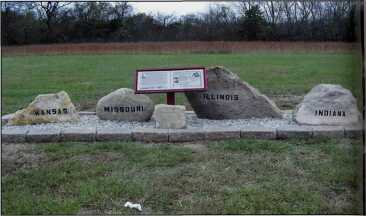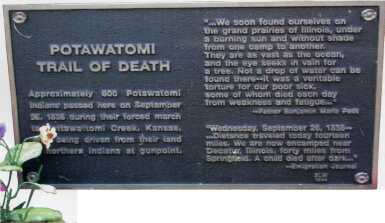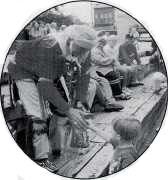R e m e m b e ri n g t h e l o n g m a r c h
Potawatomi descendants to honor trail of exiled ancestors

The Father Benjamin Petit Memorial located in Linn County, Kansas, commemorates contributions made by the missionary during the Potawatomi travels. The boulders are taken from the four states the Potawatomi traveled through.
|
By Nathan Hall
On May 26th, 2005, the Potawatomi Trail of Death Commemorative Committee met in Springfield to remember — and to organize. Shirley Willard, past president of the Fulton County (Indiana) Historical Society and a Potawatomi descendant, led the meeting, which focused on the history and future of the Trail of Death, and the formation of a new association to preserve its memory.
Willard said the Potawatomi Trail of Death Association would help look after and care for 75 historical markers that commemorate the Potawatomi Trail of Death. A variety of interested groups donated money to help erect the markers, and the creation of the association would give the markers proper care from a centralized organization.
Willard said the association's future goals include establishing highway signs that mark the 660-mile trail and creating a Potawatomi Trail of Death Association website, which will feature information and maps related to the Potawatomi Trail of Death.
The Potawatomi Trail of Death Association will hold their first annual meeting at 7:30 p.m., on September 16, 2005, at the Fulton County

One of the 75 historical markers commemorating the 660 mile Potawatomi Trail of Death.
|
Museum in Rochester, Indiana, to elect officers and to establish funding options.
On that same weekend, the 30th annual Trail of Courage Living History Festival will be held on September 17-18, 2005, at the Fulton County Historical Society grounds located four miles north of Rochester on US 31. The festival re-visits life in the 1830s before the forced removals of the Potawatomi. The event features traditional foods, crafts, music, and dance. The Trail of Courage honors a different Potawatomi family that had ancestors on the Trail of Death. A descendant of Chief Shipsheqana, Rudy Vallego of East Moline, Illinois, will be honored this year.
In 1836, the Potawatomi Indian tribe signed a treaty to move their people from their dwelling in northeastern Indiana. One Indian leader, Chief Menominee, refused to sign. Menominee accused the U.S. government of getting tribesmen drunk to sign the treaty and claimed that his name had been forged. Menominee and several other Potawatomi chiefs wrote three letters in an attempt to get President Andrew Jackson and Secretary of War Lewis Cass to void the treaties, which later became known as "The Whiskey Treaties" because of how they were conceived.
6 |ILLINOIS HERITAGE
Menominee was convinced President Jackson never heard the claims of the Potawatomi and refused to leave his land under any circumstances. "My brother, the President, is just; but he listens to the word of his young chiefs who have lied; and when he knows the truth, he will leave me to my own. I have not sold my lands. I will not sell them. I have not signed any treaty and I shall not sign any. I am not going to leave my lands, and I do not want to hear anything more about it."
Because Menominee refused to comply with the treaty, Indiana Governor David Wallace called on General John Tipton to remove the Potawatomi tribe from northern Indiana. On September 4, 1838, the forced removal of some 840
 Potawatomi Indians by foot from northeastern Indiana to eastern Kansas began.
Potawatomi Indians by foot from northeastern Indiana to eastern Kansas began.
The Potawatomi traveled through Indiana, Illinois, and Missouri before reaching their destination. They headed south to central Indiana camping in towns such as Rochester, Logansport, and Lafayette. They then traveled East through the Central Illinois prairie, camping in towns such as Danville, Springfield, Jacksonville, and Quincy. In Jacksonville, a town band serenaded the Potawatomi with music, and townspeople offered the Potawatomi food and tobacco. After crossing the Mississippi River at Quincy, the Potawatomi began to move southeast through Missouri, camping in towns such as Paris, Keytesville, and Lexington before reaching eastern Kansas. Fewer than 800 Potawatomi would end up seeing the destination of Osawatomie, Kansas, on November 4, 1838, two months after they began. Many of those who died were children.
Pe-pish-kay, a Potawatomi Indian who survived the 660-mile journey, carried the sorrow of forced removal all the way to the final destination. "We have now arrived at our journey's end. The government must now be satisfied. We were taken from homes affording us plenty, and brought to a desert—a wilderness—and are now to be scattered and left as the husbandman scatters his seed."
In recent years, lawmakers representing the four states the Potawatomi traveled through declared the Trail of Death a Regional Historic Trail.
Nathan Hall is a summer intern at The Illinois State Historical Society and a senior English major at the University of Illinois at Springfield.
ILLINOIS HERITAGE| 7
|

